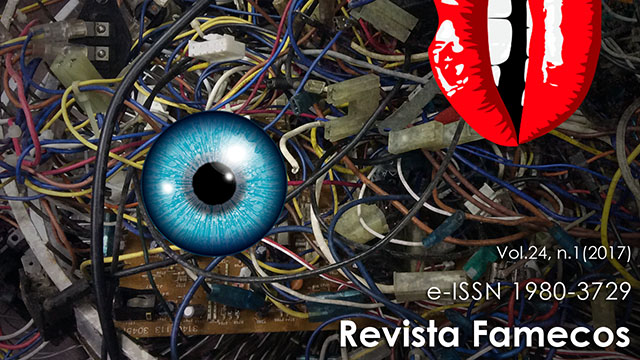Lusophone Media in the U.S.: Differences between the Florida and the Northeast Corridor Regions
DOI:
https://doi.org/10.15448/1980-3729.2017.1.23829Keywords:
Lusophone media. Ethnic media. Journalism.Abstract
In this paper, we present a discussion of the ethnic media targeting the more than 2 million immigrants from Portugal and its former colonies (particularly Brazil, Cape Verde, and Azores) living in the United States. These groups compose what we refer to as the lusophone. The goal is to understand how media targeting the lusophone diaspora negotiates a landscape where consumers’ national origin is distinct, but different patterns of assimilation exist. In particular, we uncovered two interesting patterns of geographical distinction in the media. The first serves the northeastern portion of the United States, with a larger and more culturally diverse Portuguese population and the second in Florida, which serves a more recent community of Brazilian immigrants. New media, the Internet in particular, also plays a vital role in both regions. We found that radio stations and newspapers targeting these populations have a limited online presence, but seem to remain a vital source of information and possibly still aid in immigrant integration and assimilation, which has been historically documented in ethnic media.Downloads
References
Abrams, J. R., Eveland, W. and Giles, H. The effects of television on group vitality: Can television empower nondominant groups? Communication Yearbook, n. 27, p. 193-219, 2003. Retrieved from: http://dx.doi.org/10.1207/s15567419cy2701_7
Access: 3 Mar. 2016.
Bakoy, E. Television and ethnic minorities. Norsk Tidsskrift for Migrasjonsforskning, n. 1, p. 25-41, 2006.
Beserra, B. From Brazilians to Latinos? Racialization and Latinidad in the making of Brazilian carnival in Los Angeles. Latino Studies, n. 3, p. 53–75, 2005. Retrieved from: http://dx.doi.org/10.1057/palgrave.lst.8600131
Access: 14 May 2016.
Brasileiros no Mundo. Imprensa e Midia Brasileira no Exterior. Retrieved from: http://www.brasileirosnomundo.itamaraty.gov.br/acomunidade/imprensa-e-midia-brasileira-no-exterior
Access: 3 Mar. 2016.
Brazilian Voices. Quem Somos. Retrieved from: http://www.brazilianvoice.com/1-quem-somos
Access: 3 mar. 2016.
Carvalheiro, J. R. Consumo mediático e identidades dos ‘lusodescendentes’ em França: o ‘étnico’ e o ‘mainstream’. Livro de Actas – 4º SOPCOM, 2005. Retrieved from: http://www.bocc.ubi.pt/pag/carvalheiro-ricardo-consumo-mediatico-identidades-luso-descendentes-franca.pdf
Access: 14 maio 2016.
Chen, W. Internet-usage patterns of immigrants in the process of intercultural adaptation. Cyberpsychology, Behavior and Social Networking, n. 13, p. 387-399, 2010. Retrieved from: http://dx.doi.org/10.1089/cyber.2009.0249
Access: 14 May 2016.
Cunha, M. J. C. and Mota, C. M. L. Migrant Identity in the newspaper of transplanted community. Revista FSA, 2013. Retrieved from: http://dx.doi.org/10.12819/2013.10.4.5
Access: 14 May 2016.
Fisher, G. A., and Model, S. Cape Verdean identity in a land of black and white. ETHNICITIES, n. 12,v. 3, p. 354-379, 2012. Retrieved from: http://dx.doi.org/10.1177/1468796811419599
Access: 14 May 2016.
Giles, H., Bourhis, R. and Taylor, D. Towards a theory of language in ethnic group relations. In Language, ethnicity, and intergroup relations. New York: Academic Press, p. 307-348, 1997.
Helzer, J., & Machado, E. The new blue islands: Azorean immigration, settlement, and cultural landscapes in California’s San Joaquin valley. The California Geographer, n. 51, p. 1-19, 2011.
Holmes, R. The future of social media? Forget about the U.S., look to Brazil. Forbes Magazine, 12 Sep. 2013.
Horizontes, Music of Latin America on KUT-FM. (n.d.). Retrieved from: https://www.facebook.com/pages/Horizontes-Music-of-Latin-America-on-KUT-FM-Austin/114736318561375?sk=info&tab=page_info
Access: 23 Nov. 2014.
Jouet-Pastre, C., & Braga, L. J. Community-based learning: A window into the Portuguese-speaking communities of New England. Hispania, n. 88, v. 4, p. 863-872, 2005. Retrieved from: http://dx.doi.org/10.2307/20063215
Access: 23 Nov. 2014.
La Pastina, A. and Straubhaar, J.D. Multiple proximities between television genres and audiences: The Schism between telenovelas’ global distribution and local consumption. International Communication Gazette, n. 67, p. 271-288, 2005. Retrieved from: http://dx.doi.org/10.1177/0016549205052231
Access: 18 Sep. 2008.
Latest data on US Facebook age and gender demographics. Social Times. Retrieved from: http://www.adweek.com/socialtimes/latest-data-on-us-facebook-age-and-gender-demographics/213798?red=if
Access: 18 Sep. 2008.
Laureano, C. S. A Rádio Alfa e a comunidade portuguesa em França: Estudo de caso sobre a relação entre media e identidades. Master Thesis, Universidade da Beira Interior, Portugal, 2011.
Laversuch, I. M. The politics of naming race and ethnicity: Language planning and policies regulating the selection of racial ethnonyms used by the US Census 1990–2010. Current Issues in Language Planning, n. 8, p. 365-82, 2007. Retrieved from: http://dx.doi.org/10.2167/cilp128.0 Access: 18 Sep. 2008.
Marcus, A. P. (Re)creating places and spaces in two countries: Brazilian transnational migration processes. Journal of Cultural Geography, n. 26, p. 173-98, 2009. Retrieved from: http://dx.doi.org/10.1080/08873630903003672
Access: 18 Sep. 2008.
Marcus, A. P. Sex, color, and geography: Racialized relations in Brazil and its predicaments. Annals of the Association of American Geographers, n. 103, p. 1282-1299, 2013. Retrieved from: http://dx.doi.org/10.1080/00045608.2012.700605
Access: 18 Sep. 2008.
McDonnell, J. and de Lourenço, C. You’re Brazilian, right? What kind of Brazilian are you? The racialization of Brazilian immigrant women. Ethnic and Racial Studies, n. 32, p. 239-256, 2009. Retrieved from: http://dx.doi.org/10.1080/01419870802361328
Access: 18 Sep. 2008.
Morrison, M. and James, S. Portuguese immigrant families: The impact of acculturation. Family Process, n. 48, p. 151–66, 2009. Retrieved from: http://dx.doi.org/10.11 11/j.1545-5300.2009.01273.x
Access: 18 Sep. 2008.
Ortman, J. M., and Shin, H. B. Language projections: 2010 to 2020. In Annual meetings of the American Sociological Association, Las Vegas, NV, August, p. 20-23, 2011.
Perez, A. D. and Hirschman, C. The changing racial and ethnic composition of the US population: Emerging American identities. Population and Development Review, n. 35, p. 1-51, 2009. Retrieved from: http://dx.doi.org/10.1111 /j.1728-4457.2009.00260.x
Access: 18 Sep. 2008.
Rodriguez, A. Making Latino news: Race, language and class. Aztlan: A Journal of Chicano Studies, n. 24, p. 13-47, 1999.
Sangillo, G. DEMOGRAPHICS - who’s Hispanic?, 2002. Retrieved from: http://www.nationaljournal.com/njmagazine/nj_20020608_11.php Access: 18 Apr. 2014.
Stefanone, M. A., Lackaff, D., and Rosen, D. The Relationship between traditional mass media and ‘‘social media’’: Reality television as a model for social network site behavior. Journal of Broadcasting & Electronic Media, n. 54, v. 3, p. 508-525, 2010. Retrieved from: http://dx.doi.org/10.1080/08838151.2010.498851
Access: 18 Apr. 2014.
Straubhaar, J. D. Beyond media imperialism: Asymmetrical interdependence and cultural proximity. Critical Studies in Mass Communication, n. 8, p. 39-59, 2005.
Subervi-Vélez, F.A. The mass media and ethnic assimilation and pluralism: A review and research proposal with special focus on Hispanics. Communication Research, n. 13, v. 1, p. 71-96, 1986. Retrieved from: http://dx.doi.org/10.1177/009365028601300105
Access: 18 Apr. 2014.
Torres-Saillant, S. The Unlikely Latina/os: Brazilians in the United States. Latino Studies, n. 6, v. 3, p. 466-477, 2008. Retrieved from: http://dx.doi.org/10.1057/lst.2008.49
Access: 18 Apr. 2014.
U.S. Census Bureau. National Population Projections. Washington, DC: U.S., 2008.
Census Bureau. Retrieved from: http://www.census.gov/population/www/projections/2008projections.html Access: 18 Apr. 2014.
U.S. Census Bureau. 2009 National Population Projections (Supplemental). Washington, DC: U.S. Census Bureau. Retrieved from: http://www.census.gov/population/www/projections/2009projections.html Access: 18 Apr. 2014.
U.S. Census Bureau. American Community Survey. Washington, DC: U.S. Census Bureau. Retrieved from: http://www.census.gov/acs/www/ Access: 18 Apr. 2014.
Vianna, G. V. Saudades da minha terra: reafirmação dos laços de pertencimento por meio da recepção de rádios na internet por brasileiros imigrantes, 2005. Retrieved from: http://www.iaspmal.net/wp-content/uploads/2012/01/GracielaValadares.pdf
Access: 4 abr. 2016.
Viswanath, K. and Arora, P. Ethnic media in the United States: An essay on their role in integration, assimilation, and social control. Mass Communication and Society, n. 3, p. 39-56, 2000. Retrieved from: http://dx.doi.org/10.1207/S15327825MCS0301_03 Access: 18 Apr. 2014.
Wilkinson, K.T. Language difference in the telenovela trade. Global Media Journal, n. 2, 2003.
Williams, J. R. And yet they come: Portuguese immigration from the Azores to the United States. New York: ERIC, 1982.
Williams, J. R. In pursuit of their dreams: A history of Azorean immigration to the united states. Center for Portuguese Studies and Culture, University of Massachusetts, Dartmouth, 2007.
Downloads
Published
How to Cite
Issue
Section
License
Copyright
The submission of originals to Revista Famecos implies the transfer by the authors of the right for publication. Authors retain copyright and grant the journal right of first publication. If the authors wish to include the same data into another publication, they must cite Revista Famecos as the site of original publication.
Creative Commons License
Except where otherwise specified, material published in this journal is licensed under a Creative Commons Attribution 4.0 International license, which allows unrestricted use, distribution and reproduction in any medium, provided the original publication is correctly cited.






